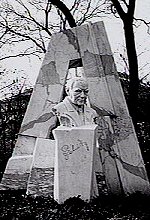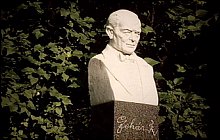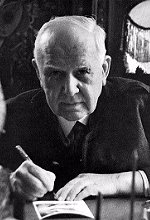| [naar
inhoudsoverzicht muziekgeschiedenis]
[naar
inhoudsoverzicht korte biografieen]
[terug naar inhoud
Lehar-biografie 2]
[naar
literatuurlijst]
inho
|
BIOGRAPHY second part (1914-1948)
World War I
The twelve operettas, which Lehár composed in the next fifteen years,
could not score the same success as in the season 1909/1910. Neither
„Eva" (1911) nor „Die ideale Gattin" (1913, a revision of the older work
„Der Göttergate") were successful in the log run. In „Endlich allein"
(1914) the composer ventured a dramaturgy, which was an absolute stage
novelty: During a whole act, a couple sings of its love on a summit. The
melody of this „summit duet" („Schön ist die Welt") ranks with Lehár's
most known ideas.
Though the First World War (1914-1918) turned not out at all to
be an era of stagnation of the operetta scene - in 1915 and 1916,
the „Csárdásfürstin" and the „Dreimäderlhaus" started
their triumphant march - Lehár kept very much in the background
during this period.
He was affected by the war: He conducted several concerts for
wounded soldiers. He composed the lieder cycle „Aus eiserner Zeit" and
the symphonic poem „Fieber", widely propagated was his setting to music
of the Austrian riding lied by Hugo Zuckermann, which resigned general
tone is far removed from the official jingoism: „signed general tone is
far removed from the official jingoism: „Yonder on the edge of the meadow
perch two jackdaws; do I fall on the shores of the Danube? Do I die in
Poland?" Already in November 1914, he heard of the serious wounding
of his brother Anton, which life could only be saved by amputating his
left leg. In the immediate post-war years, Anton Lehár played a
key part in Emperor Karl's attempts to come again into power in Hungary.
Hungarian color had also Lehár's only operetta of the wartime, which
lasted long: „Wo die Lerche singt" (1918).
Post-war years
The period from 1918 to 1925 was for Lehár a phase
of experimenting, of search for new musical forms of expression appropriate
to the changed circumstances of the time. In „Die blaue Mazur" (1920) Lehár
tried once more to emphasize the traditional European dance rhythms (waltzes,
marches, mazurkas, polonaises), which entered into a dangerous competition
with the American rhythms influenced by Jazz. The attempt failed. Lehár
embarked now himself on this for him new - and never really accepted -
musical language and composed „Die Tangokönigin", in which he worked
up - anew in vain - the music of the „Göttergatten". The works until
1925
were succès d'estime and are fallen into oblivion today in most
cases: „Frühling", a one-act play composed for the Viennese revue
„Hölle", „Frasquita" (with the popular love song „Schatz, ich bitt'
dich, komm heut nacht"), „Die gelbe Jacke" (the unsuccessful first version
of the future world success „Das Land des Lächelns") and the vaudeville
„Cloclo".
Lehár felt his friendship with Giacomo Puccini, which began
with Puccini's first post-war visit of Vienna in 1920, to be a confirmation
of his way and a strengthening of his artistic self-confidence. It was
not a one-sided subordination of the operetta composer to the celebrated
composer of the „Bohème" and the „Butterfly". Puccini had also words
of admiration for Lehár: „I can't tell you how glad I was in
meeting you closely and being allowed to admire your kindness and the melodies
of your world conquering music." But Lehár suffered all his
life from the Richard Strauss' sharp rejection or even contempt. Already
in 1940, he said: „The danger, which threatens our whole cultural
level by Lehár and his companions and to which it has already succumbed
for the most part, can not be settled anymore with noble disregard."
World successes of the twenties

The Lehár monument
In 1921, Lehár made friends with a singer, who became
known and famous as the Lehár tenor absolute: Richard Tauber. Tauber's
interpretation of Joszi in „Zigeunerliebe" enraptured the composer. The
star parts of the late twenties were sized specially on Tauber's personality
and voice, above all they had to include a „Tauber lied", the respective
highlight of the work, which, repeated many times, determined the success
of the whole operetta.
„Paganini"
With „Paganini" (1925) began the new series of successes, which document
virtually Lehár's „artistic renaissance" and changed style. The
burlesque and buffo-like elements of the operetta receded now into the
background, a more serious trait - or a more sentimental one, like his
opponents said - directed hereafter the action, which renounced mostly
the so far obligatory „happy end".
„Paganini" led off here: The violinist had to renounce his love
for the young princess Anna Elisa. Richard Tauber's highlight was the romance
„Gern hab' ich die Frau'n geküßt". Worldwide known were also
„Liebe,
du Himmel auf Erden" and the duet „Niemand liebt dich so wie ich".
„Der Zarewitsch" and „Friederike"
Hardly less successful than „Paganini" was „Der Zarewitsch" (1927). Already
since 1917, the composer concerned himself with its material. In
the libretto the motive of renunciation is placed again in the center.
Alexej, the title hero, is an unworldly young man frightened by women.
To prepare him for the matrimony, the ballerina Sonia, dressed up as a
man, is smuggled into his rooms. The young people fall in love and flee.
But the inevitable separation comes in Naples. Sonia had to renounce and
even to lead the crown prince back to his duty and to obedience.
In the next work, „Friederike" (1928), Goethe himself entered
the operetta scene. The librettists Ludwig Herzer and Fritz Löhner
showed the prince of poets as juvenile lead of Friederike Brion. „Friederike"
split the public like no other work by Lehár: It achieved (with
Käthe Dorsch in the title role) great triumphs with the audience,
but the critics and particularly the writers damned it as a matchless extreme
of the decadence.
„Das Land des Lächelns"
„Das Land des Lächelns" (1929) turned out to be a utmost successful
new adaption of the „Gelbe Jacke" of 1923. All components of the
late and „serious" Lehár operetta tending towards the opera are
united here: the collision of different nationalities (Europe and China),
characterized by different musical worlds, the motive of renunciation (prince
Sou-Chong renouces Lisa,she went back to Europe when she is overwhelmed
by homesickness) and the singable „Tauber lied", „Dein ist mein ganzes
Herz". The melody of this lied occurred episodically already in the „Gelbe
Jacke", now it received the status of tenor highlight. Alfred Rotter, the
director of the Metropol-Theater in Berlin, heard the song on the telephone.
He decided spontaneously on the adoption of the operetta, which ranked
from the day of its première, on October 10th 1929, and ranks
till today with the favorites of the public.

The Lehár-monument
The „conquest" of the opera house of Vienna: „Giuditta"
While „Der Zarewitsch", „Friedrike" and „Das Land des Lächelns" were
performed for the first time in Berlin, Lehár decided to stage „Giuditta",
composed in 1933, in Vienna. The scene of the première on
January
20th 1934 was the opera house of Vienna. The wish, which the composer
had since the refusal of „Kukuschka" by Gustav Mahler, was fulfilled with
that. Though „Giuditta" does not belong clearly to the genre of the operetta,
but more to the genre of the comic opera, a vehement debate started in
Vienna on the question if a work of the „lightly draped Muse" has the right
to be on stage at the opera house of Vienna. The first performance, conducted
by the composer personally and broadcast by more than hundred radio corporations,
had a great success with the public, but was mainly condemned by the press.
„Giuditta" was Lehár's last work. During the following
years, the composer devoted his work to the „Glocken-Verlag", a publishing
house he had founded in 1935 and that he managed with great commitment.
He negotiated personally on royalties with the theaters, organized the
dispatch of music and supervised the retail of music.
Late years
| The annexation of Austria by Hitler Germany in March 1938 put
Sophie and Franz Lehár in a problematic situation. On the one hand,
Hitler was a declared admirer of Lehár's music (he had a special
liking for the „Merry Widow", on the other hand, Lehár was „compromised"
through his cooperation with Jewish librettists, but above all his wife
Sophie had Jewish origins. Nevertheless, he refused all the propositions
to begin a new life abroad. He was now 68 years old, he did not want to
give up his comfortable homes in Vienna and Bad Ischl and felt sufficiently
secure through his notoriety. While his librettists Fritz Grünbaum
and Fritz Löhner were murdered in concentration camps, while his wife
lived constantly under the sword of Damocles of the imminent deportation,
the composer himself officiated as cultural figurehead of the regime, was
honored with the award of the ring of honor of the city of Vienna and the
Goethe medal on the occasion of his 70th birthday and saw the performance
of „Das Land des Lächelns" at the opera house of Vienna. Franz and
Sophie Lehár spent the last phase of the war in Bad Ischl. Their
Viennese home, the „Schikaneder-Schlößl" fell a prey to plunders.
Lehár bore the loss of his private archives, which he had compiled
within decades, with resigned calm: „What should say other people who lost
their fathers, sons and husbands?" |

Franz Lehár (1945) |
The entry of the US troops came about without resistance and orderly
during the days around Lehár's 75th birthday. The American soldiers
heard that the composer of the „Merry Widow" lived in the town. They went
to see him, received pictures and autographs and assumed a respectful and
deferential attitude. This entailed sharp polemics in the press. They reproached
Lehár for having forsaken his homeland in times of distress. In
Zurich, he met Richard Tauber again, who spent the years of emigration
in the Anglo-American area. Lehár's wife Sohie died in September
1947.
In summer 1948, the composer returned as sick and broken man
to Bad Ischl, where he was received with cheers. He settled his estate.
He devised his villa to the city of Bad Ischl, provided that they convert
it into a Lehár museum. His death on October 24rd 1948 caused
worldwide sympathy. The broadcasting corporations of numerous countries
organized commemorative programs and concerts. A great many people were
present, when Lehár was buried on October 30th in Bad Ischl.
Here a monument dedicated to him was unveiled in 1958. The theater
of the town is named after him.
|